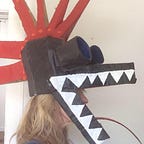Trial and Error in Creating a Perfect Plaster Cast
When I pitched this art installation to my students at Cleveland High School of Digital Arts I thought I knew exactly how we were going to create it. The plan was to have them design and plan out an installation of arms and hands….then we would get our hands dirty.
I did not want to make a plaster mold of our hands to refill with plaster liquid, as that would be quite expensive (I wanted A LOT of arms and hands for a bigger impact) and time consuming. Also, this process would result in a fairly heavy plaster final product. I wanted something light and sturdy that we could hang easily.
My first thought was to work with plaster strips, which is essentially gauze that has plaster powder already on it. Back in the day they used to make casts for broken bones out of this stuff. I worked with plaster strips before, but never to cast my own arm with it. I found step-by-step instructions online that showed how to make a plaster arm by using plaster strips. I usually do a trial run before the class starts just so I know what to expect, but looking at these instructions they were so cut and dry, I thought I could just wing it.
Well, lesson learned. The cooking spray to prevent skin from sticking to the plaster was not thick enough, and there was a lot of arm hair pulling and painful grunts on the day we attempted the plaster casting. Also, the instructions said to cast the arms/hands in two separate parts. This made it difficult to keep both parts of the cast on their body as it was drying. One side or the other kept popping off. When it came time to piece the two sides together, the seam was alway uneven. It looked sloppy and misshapen. After that first class I knew I had to figure out the things that were not working.
Firsy, I purchased a large quantity of the ultimate mold release: petroleum jelly. When I tried it out at home, this worked like a charm! The next day I brought in 5 containers of the stuff and told students they would have to smear a layer of this on their skin before any plastering. At first they were unhappy about the gooey consistency, but later realized that there would be no more hair pulling during the plaster mold removal.
Second, I tried to figure out a way we could cast the arm/hand in one piece, but pull it off easily for minimal repair. I came up with the idea to have the students draw two long lines on their casting arm. One line went from the first knuckle of the thumb to further down the arm. The other line went from the first knuckle of the pinky to further down the arm. These would be parallel to each other for even spacing. The idea was to have the students cover everything on their arm with plaster EXCEPT for these 2 lines. This helped create an empty seam on either side so when the plaster dried they could pull the piece open like a clam shell and slide their hand out.
I tried it out, and it worked! The next day my students were able to remove their hands and the only seam they had to repair was along the wider part of the arm. They were able to make several hands and arms in different positions using this technique.
It was probably good for the students to see how an artist has to make changes when projects don’t go according to plan. Problem solving and persistence are important! Ultimately, these hands became part of a new installation in the school building, and I was as happy as the students with how it turned out.
